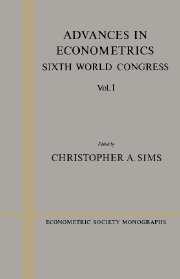2 - Time series with strong dependence
Published online by Cambridge University Press: 05 January 2013
Summary
INTRODUCTORY BACKGROUND AND DISCUSSION
Introduction
Much econometric data are collected as time series. It is rarely felt reasonable to assume that an observed time series realizes a sequence of independent and identically distributed (iid) random variables. As a result, a huge variety of parametric, semi-parametric, and non-parametric models has been proposed to describe aspects of the behavior of time series. These models have found several uses. They have been used in forecasting. They have been used to measure the dependence between economic variables. They have been used to test hypotheses propounded by economic theory. In a more indirect way, they have been used to describe latent, unobserved, variates, which may be of economic interest in themselves, or which, as “disturbances,” have properties which are relevant to the development of robust and efficient rules of statistical inference.
Relaxing only the “identity of distribution” part of the iid assumption affords considerable extra generality. Apparently smooth, persistent changes in level or periodic fluctuations have, for many years, been modeled by polynomial or trigonometric functions of time, which are fitted by linear regression techniques. More recently, it has been found possible to estimate regression functions of time that are non-parametric and regression coefficients that are non-parametric functions of time. Semi-parametric regression models, which for example involve a parametric component and an additive non-parametric function of time, have also been of recent interest. Not only the mean, but the variance and other features, have been modeled as parametric or non-parametric functions of time.
- Type
- Chapter
- Information
- Advances in EconometricsSixth World Congress, pp. 47 - 96Publisher: Cambridge University PressPrint publication year: 1994
- 114
- Cited by

